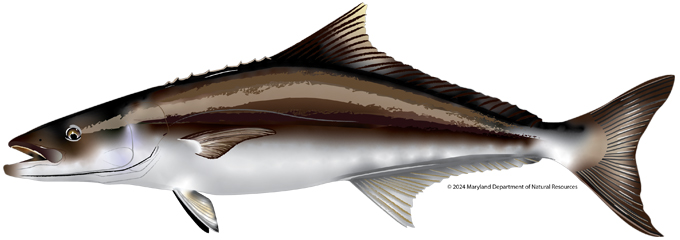| Cobia |  |
Cobia | | Rachycentron canadum | (A.K.A. black kingfish, black salmon, ling, lemonfish, crabeater, prodigal son and black bonito)
| Key Distinguishing Markings:
- The cobia has a long body that that is blackish on the back and brown on the sides.
- Two silvery bands sandwich a dark band that runs along its sides from the head to the tail.
- Its belly is yellowish- or grayish-white.
- Its flattened head has a large mouth with a protruding lower jaw.
- Seven to 10 sharp spines run along the front of its dorsal fin, and its tail fin is forked.
View the Cobia Album
| Distribution:
- These fish can be found in warm-temperate to tropical waters of the West and East Atlantic Ocean, throughout the Caribbean, and in the Indian Ocean off the coast of India, Australia, and off the Pacific coast of Japan. It is eurythermal, tolerating a wide range of temperatures, from 1.6 to 32.2°C.
- Cobia live in the Bay’s deep, open waters
| Size:
- Cobia usually grow 3 to 4 feet long and weigh more than 50 pounds
- Maximum length of 2 m (78 in) and maximum weight of 78 kg (172 lb),
| Habitat:
- Cobia live in the Bay’s deep, open waters; often found in the shade of wrecks, buoys and pilings. Mostly solitary, cobia will sometimes form small groups.
- They are pelagic, but may enter estuaries and mangroves in search of prey.
| Spawning:
- The cobia is a pelagic spawner, releasing many tiny (1.2 mm), buoyant eggs into the water, where they become part of the plankton.
- These eggs float freely with the currents until hatching.
- Their larvae are also planktonic, being more or less helpless during their first week until the eyes and mouths develop.
- The male matures at two years and the female at three years. Both sexes lead moderately long lives of 15 years or more.
- Breeding activity takes place diurnally from April to September in large offshore congregations, where the female is capable of spawning up to 30 times during the season.
| Fishing Tips:
- When fishing for cobia, you want to use heavy tackle. Cobia can make strong runs, pulling you into structures which can break off your line, or just generally break a line too weak to handle a big fish.
- Use natural baits; live and dead for best success.
| Fun Fact:
- The cobia resembles its close relatives, the remoras of the family Echeneidae. It lacks the remora's dorsal sucker and has a stouter body.
- Cobia are known by many different names, including crab-eater and kingfish.
- When hooked by an angler, cobia will put up quite a fight, leaping and running to escape.
| | Family: Rachycentridae | | Order: Perciformes ("perch-like") | | Class: Actinopterygii (ray-finned fishes) | References:
- Collette, B.B., Curtis, M., Williams, J.T., Smith-Vaniz, W.F. & Pina Amargos, F. (2015). Rachycentron canadum. The IUCN Red List of Threatened Species doi:10.2305/IUCN.UK.2015-4.RLTS.T190190A70036823.en
- Ditty, J. G.; Shaw, R. F. (1992). "Larval development, distribution, and ecology of cobia Rachycentron canadum (Family: Rachycentridae) in the northern Gulf of Mexico" (PDF). Fishery Bulletin. 90: 668–677.
- Resley, M.J.; Webb, K.A.; Holt, G.J. (2006). "Growth and survival of juvenile cobia Rachycentron canadum cultured at different salinities in recirculating aquaculture systems". Aquaculture. 253: 398–407. doi:10.1016/j.aquaculture.2006.12.029.
- Margaret M. Smith; Phillip C. Heemstra (2012). Smiths’ Sea Fishes. Springer Science & Business Media. ISBN 978-3-642-82858-4.
- Brown-Peterson, N.J.; Overstreet, R.M.; Lotz, J.M. (2001). "Reproductive biology of cobia, Rachycentron canadum, from coastal waters of the southern United States" (PDF). Fish. Bull. 99: 15–28.
- Reader Report: Cape Cod Cobia. onthewater.com (July 20, 2015)
- Kaiser, J.B.; Holt, G.J. (2004). "Cobia: a new species for aquaculture in the US". World Aquaculture. 35: 12–14.
- Liao, I.C.; Huang, T.S.; Tsai, W.S.; Hsueh, C.M.; Chang, S.L.; Leano, E.M. (2004). "Cobia culture in Taiwan: current status and problems". Aquaculture. 237: 155–165. doi:10.1016/j.aquaculture.2004.03.007.
- Nhfirst=V.C.; Nguyen, H.Q.; Le, T.L.; Tran, M.T.; Sorgeloos, P.; Dierckens, K.; Reinertsen, H.; Kjorsvik, E.; Svennevig, N. (2011). "Cobia Rachycentron canadum aquaculture in Vietnam: recent developments and prospects". Aquaculture. 315: 20–25. doi:10.1016/j.aquaculture.2010.07.024.
- Rachycentron canadum. FAO.org
- Benetti, D. D. (2007). Aquaculture of cobia (Rachycentron canadum) in the Americas and the Caribbean (PDF). Rosenstiel School of Marine and Atmospheric Science of the University of Miami.
- Benetti, D.D.; et al. (2003). "Advances in hatchery and growout technology of marine finfish candidate species for offshore aquaculture in the Caribbean" (PDF). Proceedings of the Gulf and Caribbean Fisheries Institute. 54: 475–487.
Illustration by Kevin Ensor, Maryland Department of Natural Resources, Fishing and Boating Services
|
|
